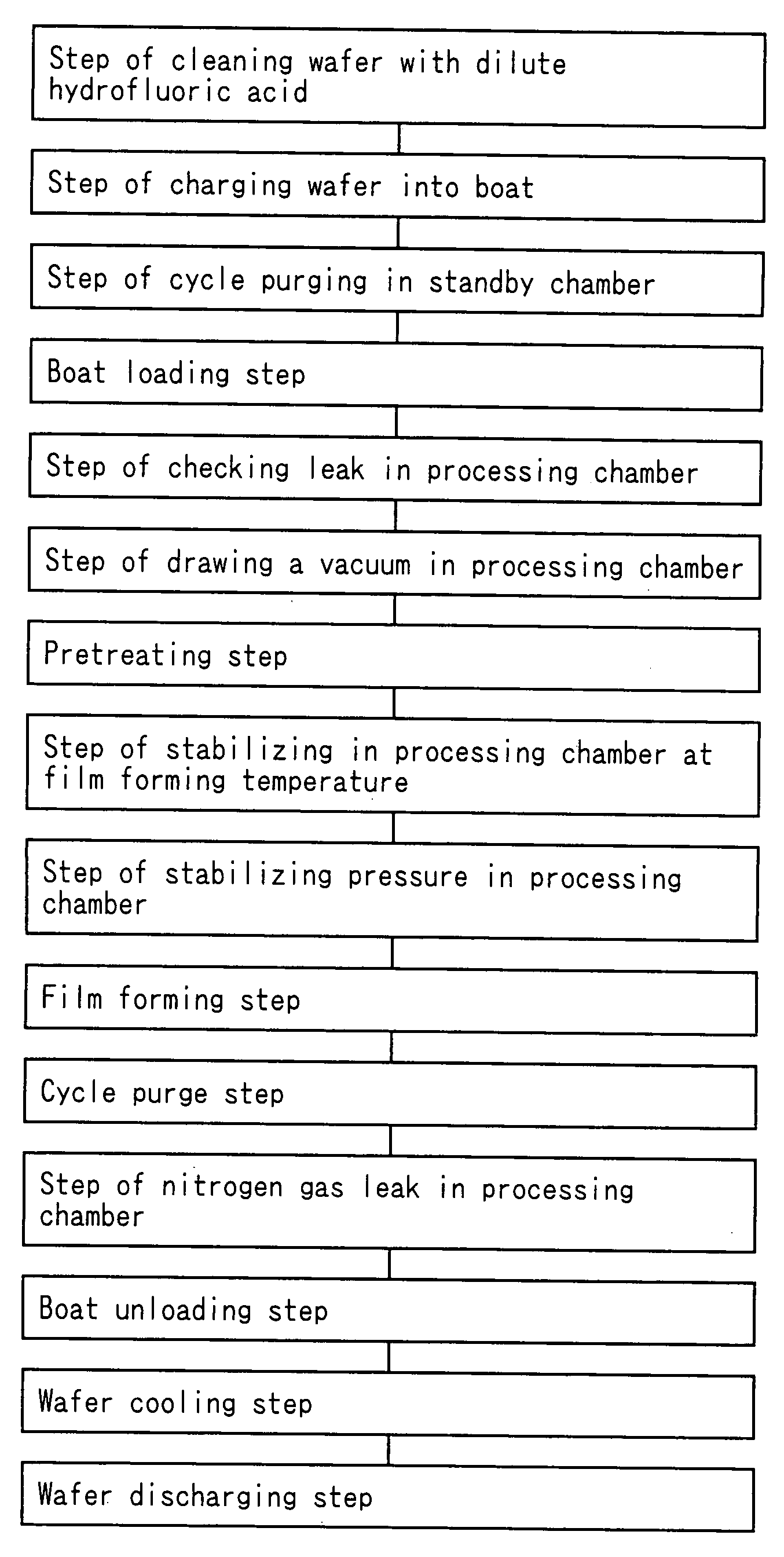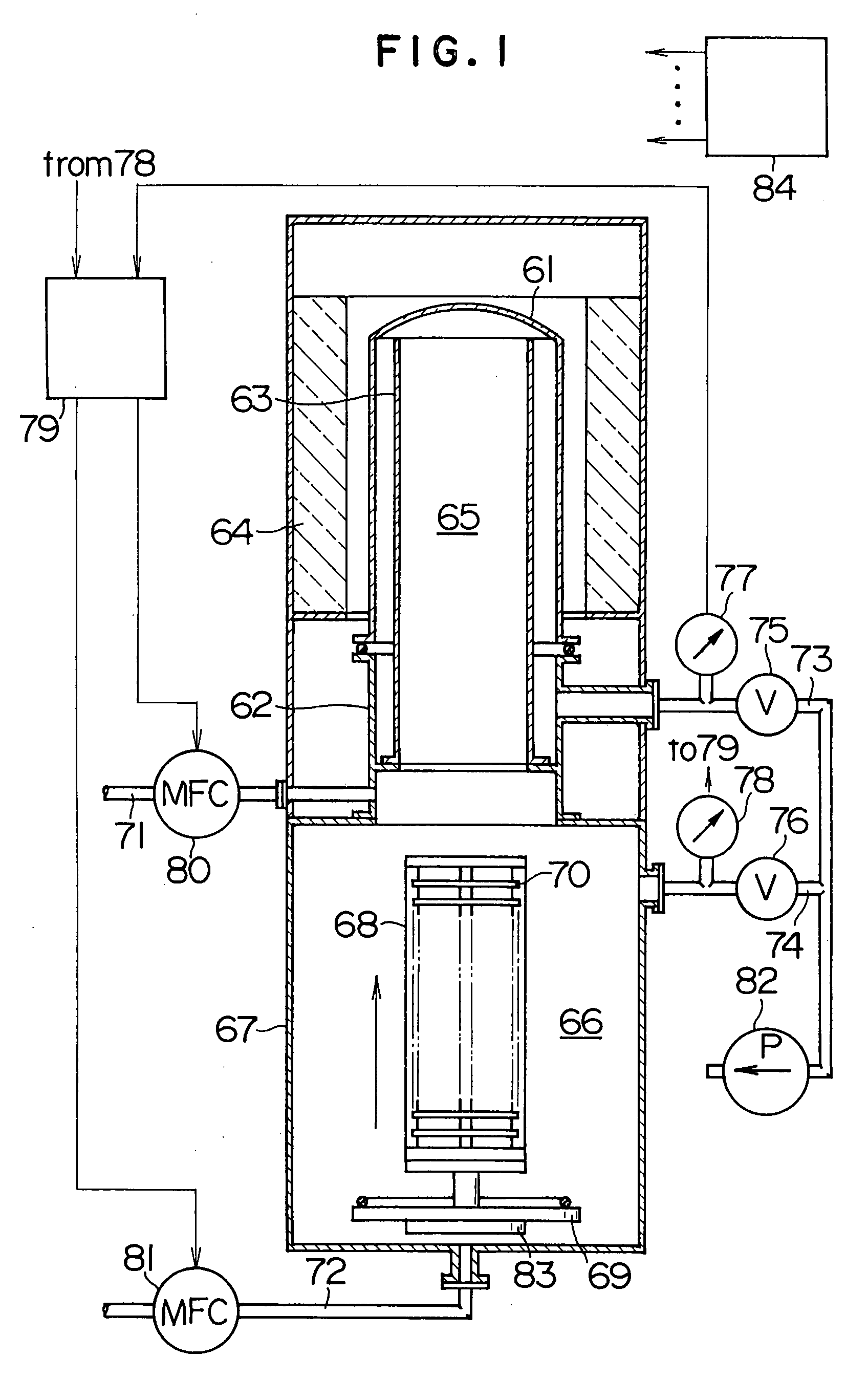Semiconductor device manufacturing method and substrate processing apparatus
a technology of semiconductor devices and processing equipment, which is applied in the direction of lighting and heating equipment, crystal growth process, polycrystalline material growth, etc., can solve the problems that components might possibly contaminate the wafer surface with impurities, and achieve the effect of satisfying cleaning effect, increasing thermal budget and heat damage to the substrate, and high quality
- Summary
- Abstract
- Description
- Claims
- Application Information
AI Technical Summary
Benefits of technology
Problems solved by technology
Method used
Image
Examples
first embodiment
[0150]Experiments performed for determining pressure dependence and temperature dependence of the interfacial oxygen density (concentration) in SiH4 purge are described next for the first embodiment.
[0151]The electrodes extending from the DRAM source and drain are used as one example of a semiconductor device requiring a low oxygen density interface. This interfacial characteristic is referred to as contact resistance. The tinier the natural oxidized film in this section, the less the contact resistance and the better the electrical characteristics.
[0152]In the experiment to evaluate this embodiment, the interfacial characteristics between the D-polysilicon film (phosphorus dope silicon film) and D-polysilicon film (phosphorus dope silicon film), were measured with SIMS (Secondary Ionization Mass Spectrometer).
[0153]The evaluation device was the apparatus of the above embodiment. In other words, a load-lock type apparatus effective in reduction of the interfacial oxygen density was ...
second embodiment
[0177]Experiments for determining the temperature dependence of the contact resistance in SiH4 purge are described next for the second embodiment.
[0178]The second embodiment evaluates the interfacial contact resistance by utilizing actual devices based on SIMS evaluation results of the first embodiment.
[0179]The SIMS results of the first embodiment showed that an SiH4 purge proved effective at a low temperature and high vacuum so that the pressure here was fixed at 10 Pa using a TMP, and the temperature was set to the two cases of 330° C. and 430° C. which are lower than the film-forming temperature (530° C.).
[0180]FIG. 4 shows the temperature dependence of the interfacial contact resistance in the SiH4 purge.
[0181]The horizontal axis indicates the SiH4 purge temperature (° C.), and the vertical axis indicates the interfacial contact resistance (ohms / pieces).
[0182]In this evaluation, the SiH4 purge temperature was changed to 330° C. and 430° C. as described previously.
[0183]The “Non...
third embodiment
[0185]Next in the third embodiment, an experiment performed to find the time dependence of the interfacial oxygen density in the SiH4 purge in the time from setting the wafer in the furnace to starting of the SiH4 purge event is described.
[0186]The time dependence (SIMS result) of the interfacial oxygen density in the time from the end of placing the wafer in the furnace to the SiH4 purge event is shown in FIG. 5.
[0187]The horizontal axis indicates the time (minutes) from completing the placement of the wafers in the furnace to the SiH4 purge event. The vertical axis indicates the interfacial oxygen density (atoms / cm2).
[0188]As shown in FIG. 5, in this evaluation the time from placing wafers in the furnace up to the SiH4 purge event was changed to 50 minutes and 15 minutes.
[0189]One can see in FIG. 5, that the shorter of the times from placing wafers in the furnace up to the SiH4 purge event possesses a slight interfacial oxygen density. That result is due to the following reasons.
[...
PUM
| Property | Measurement | Unit |
|---|---|---|
| pressure | aaaaa | aaaaa |
| pressure | aaaaa | aaaaa |
| temperature | aaaaa | aaaaa |
Abstract
Description
Claims
Application Information
 Login to View More
Login to View More - R&D
- Intellectual Property
- Life Sciences
- Materials
- Tech Scout
- Unparalleled Data Quality
- Higher Quality Content
- 60% Fewer Hallucinations
Browse by: Latest US Patents, China's latest patents, Technical Efficacy Thesaurus, Application Domain, Technology Topic, Popular Technical Reports.
© 2025 PatSnap. All rights reserved.Legal|Privacy policy|Modern Slavery Act Transparency Statement|Sitemap|About US| Contact US: help@patsnap.com



